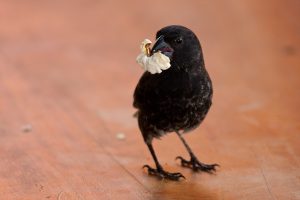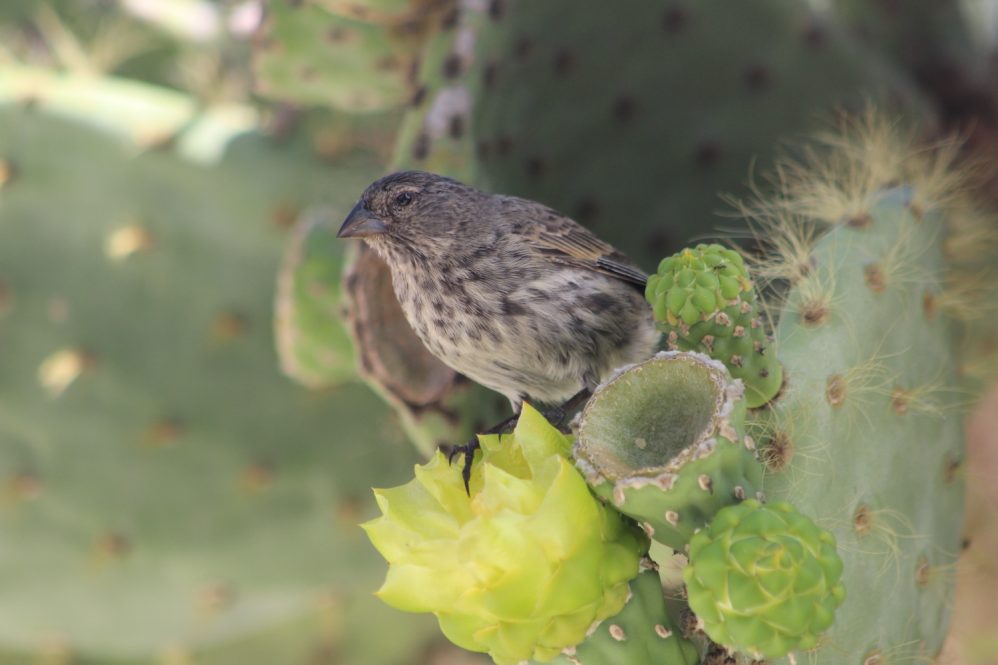Human activities like land-use changes and urban development have huge ecosystem impacts. Since organisms are shaped by their surroundings, how do they adapt during these times of upheaval? Answering this question requires looking at many complex and potentially interacting components, including the gut microbiome, which can influence multiple aspects of an organism’s health and change in response to external and internal stimuli.
Researchers in UConn’s Department of Ecology and Evolutionary Biology including NSF Postdoctoral Research Fellow Ashley Love and Associate Professor Sarah Knutie study the gut microbiome of Darwin’s Finches to see how they are adjusting to live alongside humans in their rapidly changing environment. Their findings are published in Molecular Ecology.
“Microbiomes are important for digestion, metabolism, and the development of the immune system,” says Love.
For this study, Love explains they were interested to see whether there are interactive effects of different environmental factors on Darwin’s finches’ microbiomes in the Galapagos, focusing specifically on urbanization and parasitism.
The Galapagos Islands are a unique setting for this study because Love explains that over the past several decades the island of San Cristobal has experienced a huge increase in tourism, and along with it, an increase in the residential population and shifts in the native wildlife species.
“Urbanization can shift the diets of wild organisms,” says Love. “These finches are no exception because they are feeding on things they wouldn’t normally get in the wild, such as popcorn and cookies, and all sorts of different items that are intended for humans, so diet is one route through which urbanization might affect their gut microbiomes.”
Urban development often leads to the introduction of invasive species that are oftentimes very disruptive to native ecosystems. For the Galapagos that includes the invasive avian vampire fly (Philornis downsi), which lives in the nests, and feeds on the blood of finches and can have detrimental effects on the nestling health. Love says that in some years, the effects of these ectoparasites are devastating, sometimes with up to 100% of the young in infested nests not surviving.
“It has huge conservation implications. For our study, we were looking at whether urbanization affects the microbiome and whether this invasive parasite affects the microbiome, potentially through effects on offspring immunity. We were also curious whether there are interactive effects, for example whether a combination of urbanization and parasitism might have synergistic effects on the gut microbiome.”

For this study, Love explains they identified nests in urban and non-urban settings and treated some of the nests to eliminate the flies. After the eggs were hatched, the researchers collected fecal samples from the nestlings, and when the birds fledged, the nests were collected to gather data on any flies living in the nests. With the fecal samples, the researchers can study the gut microbiomes of the nest’s former inhabitants.
The results were unexpected. Love says they did not find an interactive effect of the two variables – urban setting and the parasite — on the nestlings’ microbiome. Instead, they found separate effects for both variables on the gut microbiomes of the nestlings.
“We found that urbanization affected the bacterial diversity in the gut. We initially predicted that nestlings would have a higher bacterial diversity in their gut in the urban areas because many other studies have found this in urban organisms, but we found the opposite effect. Nestlings in the urban area had a lower diversity in their gut and we think this could be due to the food items they are feeding on, and the composition of those food items.”
Other studies have found that high-protein diets can increase diversity whereas high-fat diets tend to reduce diversity, and Love suspects this could be the case for the city-dwelling birds.
“We sit at restaurants and watch the finches grab food from people’s plates. They might be feeding on higher-fat items, and this could be one explanation for this reduction in diversity,” says Love. “We also found that urban finches had a higher abundance (total number of individuals) of bacteria in the phylum Firmicutes, which is something seen in human and animal studies when they’re fed a high-fat diet. That’s one potential explanation for what we found there.”
When the researchers looked at the effect of parasitism, they found that parasitized birds had a lower number of gut bacterial species overall (richness). Love explains this reduction in the bacterial richness could be attributed to the immune system because the gut microbiome is potentially linked to shifts in immunity. They also found a higher abundance of another bacterial genus, Candidatus Arthromitus, in the urban-dwelling finches and plan to study this and other effects of urbanization on nestling gut microbiomes and immune responses in future studies.
“One reason we were also interested in the parasitism aspect is other studies have found that having various types of parasites can alter the microbiome,” Love says. “I think a lot of these are gut parasites but we’re looking at an ectoparasite feeding at the periphery of the skin, and I often get the question about how that could affect the gut microbiome. When these parasites are feeding, the immune responses start at the periphery. They might have inflammation and we do find that birds can produce a parasite-specific antibody response. In addition to the local swelling, when a parasite is biting the birds, systemic responses and processes are happening throughout the body. That’s where we think the interface between these whole-body immune responses are potentially interacting with the bacteria in the gut, although we didn’t investigate that in the present study.”
“Our study provides new evidence that parasitism does not interact with urbanization to affect the microbiome of finch nestlings on San Cristobal Island,” says Knutie, “it also supports a growing number of studies across the islands showing that avian vampire flies and urbanization can independently influence finches and these widespread effects can have major conservation implications.”



